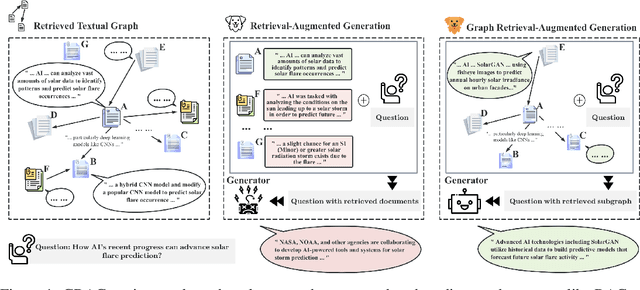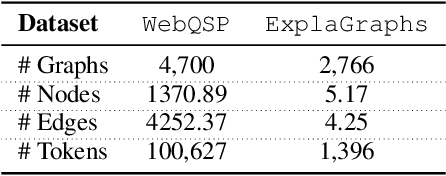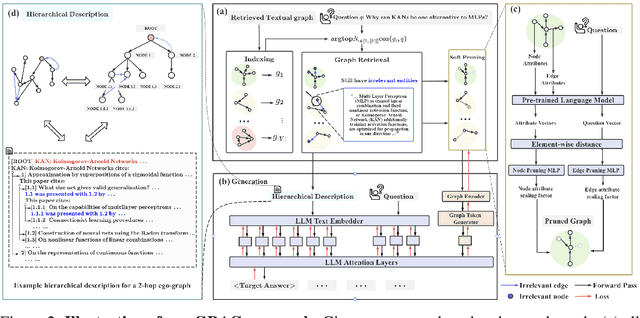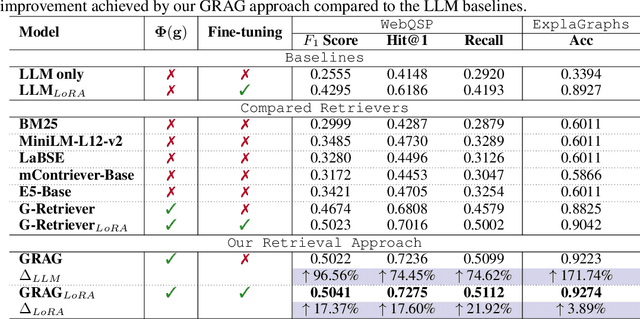Zhihan Lei
CG-RAG: Research Question Answering by Citation Graph Retrieval-Augmented LLMs
Jan 25, 2025



Abstract:Research question answering requires accurate retrieval and contextual understanding of scientific literature. However, current Retrieval-Augmented Generation (RAG) methods often struggle to balance complex document relationships with precise information retrieval. In this paper, we introduce Contextualized Graph Retrieval-Augmented Generation (CG-RAG), a novel framework that integrates sparse and dense retrieval signals within graph structures to enhance retrieval efficiency and subsequently improve generation quality for research question answering. First, we propose a contextual graph representation for citation graphs, effectively capturing both explicit and implicit connections within and across documents. Next, we introduce Lexical-Semantic Graph Retrieval (LeSeGR), which seamlessly integrates sparse and dense retrieval signals with graph encoding. It bridges the gap between lexical precision and semantic understanding in citation graph retrieval, demonstrating generalizability to existing graph retrieval and hybrid retrieval methods. Finally, we present a context-aware generation strategy that utilizes the retrieved graph-structured information to generate precise and contextually enriched responses using large language models (LLMs). Extensive experiments on research question answering benchmarks across multiple domains demonstrate that our CG-RAG framework significantly outperforms RAG methods combined with various state-of-the-art retrieval approaches, delivering superior retrieval accuracy and generation quality.
GRAG: Graph Retrieval-Augmented Generation
May 26, 2024



Abstract:While Retrieval-Augmented Generation (RAG) enhances the accuracy and relevance of responses by generative language models, it falls short in graph-based contexts where both textual and topological information are important. Naive RAG approaches inherently neglect the structural intricacies of textual graphs, resulting in a critical gap in the generation process. To address this challenge, we introduce $\textbf{Graph Retrieval-Augmented Generation (GRAG)}$, which significantly enhances both the retrieval and generation processes by emphasizing the importance of subgraph structures. Unlike RAG approaches that focus solely on text-based entity retrieval, GRAG maintains an acute awareness of graph topology, which is crucial for generating contextually and factually coherent responses. Our GRAG approach consists of four main stages: indexing of $k$-hop ego-graphs, graph retrieval, soft pruning to mitigate the impact of irrelevant entities, and generation with pruned textual subgraphs. GRAG's core workflow-retrieving textual subgraphs followed by soft pruning-efficiently identifies relevant subgraph structures while avoiding the computational infeasibility typical of exhaustive subgraph searches, which are NP-hard. Moreover, we propose a novel prompting strategy that achieves lossless conversion from textual subgraphs to hierarchical text descriptions. Extensive experiments on graph multi-hop reasoning benchmarks demonstrate that in scenarios requiring multi-hop reasoning on textual graphs, our GRAG approach significantly outperforms current state-of-the-art RAG methods while effectively mitigating hallucinations.
 Add to Chrome
Add to Chrome Add to Firefox
Add to Firefox Add to Edge
Add to Edge